Qui Bono? An American Veteran’s Views on Non-Jewish Toleration and Propagation of the Extermination Thesis
Paper presented at the 1981 Revisionist Conference
According to Cicero, L. Cassius Lohnginus Ravilla, who was Consul of the Roman Republic in 127 B.C., admonished judges involved in criminal trials to investigate the question to whose advantage a criminal act might have been committed. His famous question, which has had an influence on western juridical practice ever since, consisted of only two words: “Cui bono?“
It is my intention in this paper to pose this question in order to understand the motivations of several non-Jewish groups whose members frequently not only tolerate but actually propagate a patently questionable historical thesis. Both material and psychological motivations are to be examined here.
Jewish, and especially Zionist, exploitation and continued propagation of the “Holocaust” material have rather obvious economic and psychological motivations which have been described by a number of authors,[1] but the strange, if not apparently masochistic, toleration and even propagation of the material by non-Jewish groups have not been sufficiently summarized and discussed.
The evidence against the claim that some six million Jews were deliberately killed (largely by lethal gas) on a massive scale in labor and relocation camps as a result of a general extermination policy on the part of Germany and its wartime allies, has long been available to anyone who was objective and interested enough to examine even the simplest of demographic data available in readily accessible reference works. As early as 1951, for example, Col. John Beaty pointed out the demographic evidence against the claim in his important little book, The Iron Curtain Over America, pp. 134 ff. In more recent years such brilliant analyses of the extermination thesis as those by Prof. Arthur R. Butz and Dr. Wilhelm Stäglich have merited the attention of those who objectively seek the truth in this area.
The most obvious group which we must consider are the Germans themselves. Before considering their present sentiments and especially those of their governments with regard to the extermination thesis, we must first undertake a cursory analysis of the sentiments which prevailed in German lands during 1933 and later, along with the conditions which caused them.
In 1945, Germany and those who had held leading positions in the National Socialist government during 1933 to 1945 were at the mercy of victorious and very vindictive powers. Indeed, they were even dependent on the victors for vital food supplies. In the wake of a terrible military defeat with staggering costs in blood, territory and treasure, former members of the National Socialist German Workers’ Party also faced considerable hostility from the rest of the German population,[2] although a mere ten years before 1945 the National Socialist movement had been enjoying a great popularity as a result of its notable successes during the first years after. its accession to power in early 1933.[3]
One measure of this popularity was the Saar plebiscite of 13 January 1935, in which about 900/o of the Saar population voted to return to Germany and only about 8.8% to continue under the League of Nations. Not only did National Socialism enjoy considerable popularity in Germany itself, but at least a fair measure of admiration and approval in non-German lands. An indication of this sentiment can be seen in the Olympic games held in Berlin in 1936. In contrast to the massive boycott of the Olympic games held in. the USSR in 1980, there was certainly no massive boycott of the games in 1936. Perhaps the most important tolerant reaction to National Socialism abroad was to be found in the attitude of the vast majority of Americans to it. They wanted no formal involvement in a war against Germany in spite of powerful and influential interests which wanted such an involvement.[4] From the present vantage, there is certainly no reason to doubt the results of many private polls which showed that about 5/6ths of the American population wanted no formal part of the war raging in Europe and that this sentiment persisted rather constantly right down to 7 December 1941 in spite of the massive unemployment which still existed in the United States, even throughout the years 1940 and 1941, and in spite of the powerful forces which favored formal entry into the war against Germany, a land comparable in area to the State of Texas.
During the years 1940 and following, many individuals in the occupied lands voluntarily helped the German cause. Some of them were quite distinguished persons, such as the famous Norwegian author Knut Hamsun (1859-1952), who had won the Nobel Prize in 1920. The military figures, Marshal Petain and Admiral Horthy, to mention only two examples, also cooperated with National Socialist Germany.
Notwithstanding the popularity of National Socialism which existed during the years before the tide started to turn against the German armed forces in 1942-3, we are now confronted with German governments which not only tolerate the extermination thesis and “Holocaust” material but actively persecute those who dare to question them.[5] To understand this seemingly paradoxical phenomenon, we must understand the present position of these governments and their historical background. Both the German Federal Republic and the German Democratic Republic, its Communist counterpart in central Germany, are states which developed from the military occupation zones that existed during 1945-1949. (The eastern quarter of the area of the Reich as it existed in 1937 was incorporated into Poland and the USSR.) Within strict limitations and directives, Germans were gradually permitted ever greater authority to govern themselves and finally the two republics were founded in 1949. Even if these two states enjoy a nominal sovereignty today, they remain essentially creations of the occupying powers: The United States, Britain and France in the case of western Germany and the USSR in the case of central Germany. Somewhat parallel developments took place on a much smaller scale in Austria, which was not accorded full sovereignty until 1955, and then only with many stipulations by the victors. Austria, for example, had to promise never to join Germany again.
Many German politicians of the present generation founded and furthered their careers while disavowing National Socialism or any connections which they might have had with it (e.g., Willy Brandt). Having thus committed themselves, they are hardly in a position to be receptive or even just tolerant to historical revisionism, no matter what its merits or validity.
All three of the present German republics are faced with delicate problems with regard to the approval of other nations, for economic reasons, if nothing else. Since about 1870 Germany has been incapable of growing sufficient food for its population, which was expanding especially rapidly between about 1870 and 1941. Germany was therefore forced to export or starve, a circumstance which has brought it into conflict with other European nations that must also compete for overseas markets. This problem became even more acute after the large territorial losses of 1918 and 1945.1 recall vividly a plea for mercy made to me shortly after the war by a former National Socialist in Internment Camp No. 75 in Kornwestheim, north of Stuttgart. He pointed out that people of his nation had not had enough to eat for 30 years.
As a result of the overwhelming propaganda deluge of World War II against National Socialist Germany, the present German republics have been forced to disavow all that the Germany of 1933-1945 represented. It has generally been the policy of the three German republics to represent the German government in power during 1933-1945 (or 1938 to 1945 in the case of Austria) as an illegal usurpation and a gross discontinuity in German history. Officially, western Germany in particular has had a tendency to glorify the Weimar Republic and to consider itself the legal successor of the Weimar Republic (whose flag and motto it has readopted), even though there are important differences between the Weimar Republic and the Bundesrepublik.
The German Democratic Republic, on the other hand, represents itself as an innovation, namely the first German government of peasants and workers.
Perhaps the chief immediate reason why the Bundesrepublik has-made a great ostentation of prosecuting former National Socialists is that it has thus sought to counter a collective guilt thesis which would have been disadvantageous to the German nation as a whole.
So strong has been the reaction against the defeated National Socialist government that in a number of ways the Bundesrepublik seems to go out of its way to pursue policies which are the mirror opposite of the policies prevalent in 1933 and following years even if such policies endanger the economic, social and ethnic fabric of Germany. One notable example is the toleration of the massive assimilation (economic, if not also cultural and biological) into the German population of foreign industrial workers who are markedly different culturally from Germans, notably those from Turkey and Yugoslavia. The present very low birthrate in Germany could very well be a result of destruction of a wholesome and constructive national pride.
Both in general and in particular with regard to the extermination thesis, the policies of the Bundesrepublik must be assessed on the basis of a psychological reaction to the crushing military defeat of its predecessor government, the circumstances of the creation of the Bundesrepublik and the economic realities which the Bundesrepublik faces, both internally and externally.
Turning now from the attitudes toward the “Holocaust” material which prevail in the three present German republics that evolved in part of the former territories of the Reich, let us now examine the toleration and exploitation of the “Holocaust” material in the case of groups outside Germany.
Since the United States became the leading and most effective adversary of Germany during the course of World War II, let us consider first of all the relationship of non-Jewish groups in the United States to the “Holocaust” material.
In 1945 the tremendous damage which had been inflicted on the German population and such outstanding monuments of European civilization as Nuremberg and Dresden were there to be seen by all, including the millions of young American men who served in the American occupation forces. Many American soldiers were inclined to be sympathetic to the German population, particularily the men from the former Confederate states, whose not-all-too-remote ancestors had also known a tough enemy occupation after defeat in a war also fought largely over racial issues.
On the other hand, I know a fellow veteran of World War II who still boasts of his exploits in that tragic conflict. He is a Germanophobe and claims to have been present at the capture of Dachau, conditions at which he likes to describe with considerable exaggeration. He still proudly shows a propaganda book put out by his division just after the war. Such a man has an obvious vested psychological interest in continuing his beliefs in the flood of Germanophobic propaganda in which he has joyfully bathed during’the past 35 years. As Friedrich Nietzsche observed in his Also sprach Zarathustra with ironic accuracy: “Der gute Krieg ist es, der jede Sache heiligt.” (It is the good war which hallows every cause.)
The higher officers carrying out the occupation policies on the basis of orders and directives from Washington were concerned about the sympathy toward the German population which was present in many of the lower-ranking officers and enlisted men, who typically had much closer contact with a broad spectrum of the German population. Allegations of atrocities committed by the Germans were a most welcome aid in inhibiting this sympathy on the part of American military personnel, as well as subduing psychologically the German population, which was receiving rationed food supplies hardly above the starvation level. I recall a motion picture widely shown in German civilian theaters (around 1946, I think) concerning conditions in German labor and relocation camps. The German title was Die Todesmühlen (Mills of Death).
On a broader scale than the immediate problems of the military occupation was the sacrifice of time, blood and treasure which the American people had had to make to defeat an enemv which had been involved in a titanic struggle against communism, which many farsighted Americans had perceived as a far more dangerous enemy than National Socialist Germany. Before December 1941, bitter political battles had been fought over the question of intervention, and some time after the hostilities were over no less a figure than Senator Taft of Ohio had the wisdom, decency and courage to question the legal basis of the Nuremberg trials.
The Democratic Party, which had its men in the presidential office from 1933 to 1953 and,thus bore the essential responsibility for the conduct of the war and the postwar relationship with the USSR, welcomed any means of rationalization and justification of its conduct during this period. Democrats further welcomed any means to discredit their former adversaries on the intervention question and to counterbalance the emerging recognition on the part of many Americans that some dismal and unjust mistakes had been made in the conduct of the war, which were now beginning to pose such serious problems as the blockade of Berlin and the communist domination of eastern Europe. It is still common in certain circles to refer to the emerging recognition of the mistakes which had been committed and the wrath of the broad masses of the American people resultant from the recognition of them as “McCarthyism.” In reality, what we subsume under the term “McCarthyism” was the quite understandable anger at the Roosevelt and Truman administrations for their naive, if not criminally irresponsible, furthering of communist aims. Many opponents of “McCarthyism” continue to look to the “Holocaust” material as a political weapon and rationalization of the behavior of the Democratic Party.
Even today, over three decades after the end of World War 11, it is strange to observe the composition of the supine audiences at the “Holocaust” seminars sponsored in many cities of the United States by Jewish organizations, often on university campuses. Much of the audience consists of non-Jews who feel a necessity to seek the approval of Jews and perhaps, in some cases, still feel a necessity of rationalizing the conduct of the war by the Democratic Party. As a result of heavy Jewish influence in the American news media, especially in television, typical American political figures would not dare to question the “Holocaust” material, although many of them are doubtless aware of the reasons for doubting its validity. So effective and persistent has been the propagation of the “Holocaust” material that few adult Americans are not aware of the claim that six million Jews were murdered in German relocation and labor camps during World War II, but it is doubtful that even 1% of the American population would be able to explain the term “Operation Keelhaul,” even though it refers to one of the most disgraceful and unfortunate episodes in American history. Even if only about 3% of the American population is Jewish, that component has a political influence completely out of proportion to its numbers. The “Holocaust” material is deeply woven into the very fabric of American political life.
Let us now turn briefly to England, which undertook the grave step of declaring war on Germany on 3 September 1939 and thus staked its very existence on the defeat of Germany. There can be little doubt today that this step was hardly occasioned by an idealistic concern for the continued existence of the Polish state, a nationalistic dictatorship hardly milder and less hostile to its large Jewish population than Germany. A fortnight after the German invasion of Danzig and western Poland had begun, the USSR launched its occupation of eastern Poland against some resistance. However, England and its somewhat less eager companion-in-arms, France, hardly made a whimper of protest, let alone a declaration of war, against the second invader of Poland.[6]
The English problems with the occupation of Germany during 1945 and the years after, had a vague similarity to those of the United States in some respects, but we must also bear in mind that England had been a long-time competitor of Germany for overseas markets. Now England was in a position which enabled her to play a major role in keeping German goods out of the international trade channels of the world, at least for a few years. Paralysis of German industrial production could be maintained by such monetary policies that England helped to impose as the continued, forced circulation of the old Reichsmark notes, which was not ended until June, 1948. Many of the important factories in the British Zone were dismantled and sent to Russia, as grotesque as that might seem today. England had strong economic motivations for the psychological discrediting of its old commercial and industrial rival, and these were certainly not frustrated by the continuing inundation of the bitter hate propaganda against a prostrate Germany, including, of course, the “Holocaust” material.
England was also most heavily involved in the almost Carthaginian destruction of German cities during the long period after the declaration of the unconditional surrender policy to the end of the war, a period of about 21/2 years.[7] Although a great deal of publicity has been given to the bomb damage which England suffered during World War II (e.g., Coventry), this damage was only a very small fraction of what Germany suffered.[8] If the English had any self-recriminations for the destruction of German cities and the genuinely holocaustal killing of hundreds of thousands of civilians in the process, what could have been better for assuaging their consciences than the “Holocaust” material?
Let us finally consider a group of states which have exploited the “Holocaust” material in a most energetic manner: the USSR and its satrapal governments in eastern Europe. As we shall see, the communist lands have had compelling reasons to continue to propagate the “Holocaust” material.
At first, however, we are confronted with the question as to what extent we are dealing with a non-Jewish group in this case. There can be little doubt that in its earlier years the government of the USSR was a government largely dominated by Jews. There is even a considerable body of literature on this question and even Winston Churchill, the shrewd political opportunist par excellence, expressed his observations of the largely Jewish composition of the early Soviet government in 1920.[9] The middle classes of western Europe were well aware of the ethnic reality of communism and the brutality of communism in practice. This circumstance, perhaps more than any other of a number of factors, caused the hostility to Jews that prevailed in so many lands west of the Soviet Union during the period between the two world wars. Even in their own backyard, the ephemeral government of Bela Kun (1919) made its quite negative impression on the middle classes in western European countries.
Be that as it may, let us now consider motivations which the USSR and its postwar satrapies have had for emphasizing the “Holocaust” and similar material in their post-1945 propaganda.
The behavior of the USSR externally during recent decades has struck fear into the hearts of decent, successful people throughout the world. Before the German invasion of Russia in June, 1941 the USSR had taken by force or threats of force large areas of eastern Europe, a fact which is now not commonly recalled. Going from north to south, we first consider the war which the USSR waged in Finland. The Finns fought back bravely during the war in the winter of 1939-1940 and gained the sympathy of the world, but were finally forced to give in and make painful territorial concessions. The USSR annexed the three Baltic republics, Estonia, Latvia and Lithuania in the middle of 1940, the eastern part of Poland in September 1939 and an important part of eastern Rumania in 1940. The treatment of the populations in these lands, especially the Baltic states with their German minorities, was undoubtedly an important factor in Hitler’s decision to invade Russia, in addition to the frightening Soviet buildup of arms, particularly its tank strength, which was essentially an attack asset.[10]
In spite of the gross numerical superiority in terms of national population and numbers of tanks which the USSR had at the outset of the war between the Soviet Union and Germany, German forces were able to penetrate so far into Russia (beyond the Baltic states and Poland) that its two major cities, St.
:ersburg (communist name: Leningrad) and Moscow, were threatened within a few months. To the south, much of the agriculturally important Ukraine was occupied. Undoubtedly this catastrophe for the communists was due in large measure to the hatred of the brutal regime under which massive tyranny, famines, industrial stagnation and oppression of minorities had occured. It had to become clear to the Soviet leaders what inherent weaknesses their regime had and how close they were to defeat, in spite of the fact that the war was inherently a David-Goliath contest. By early 1943 the tide of battle began to turn as a result, due to a considerable extent to moral and material support from abroad, notably from the United States.
The spring of 1945 saw the final defeat of the numerically far inferior German forces and by 1948 the new Soviet empire was in control of nearly half of the Europe (excluding Scandinavia) which had existed west of the Soviet borders in 1938, including almost exactly half of Germany as it existed in its 1937 borders. During June 1948 to May 1949 the whole world was astonished and sobered by the affrontiveness shown by the new Soviet empire in its blockade of Berlin. By 1949 the world was also terrorized by the knowledge that the masters of this empire now had atomic bombs at their disposal, having been aided by a number of spies in this area, nearly all of whom were of Jewish origin and two of whom were executed for their treason in 1953, after a long judicial process.
As a result of a number of factors, but especially as a result of the gullibility, ignorance of foreign affairs, and even treason on the part of members of the Roosevelt and Truman administrations, the Soviet Union had been lifted from the depths to a position of great power and security. However, in spite of a sophisticated apparatus for the suppression of the populations in the occupied countries and satrapies, massive deportations and the like, a number of revolutionary movements developed against the , oppressors, which culminated in the very important Hungarian Revolution of 1956, which had tremendous psychological and political repercussions even in defeat.
Skillful and energetic propaganda efforts on the part of the Soviet rulers have undoubtedly been a big factor in the upward climb of the Soviet Union, which started from a nadir of its fortunes in 1943. The “Holocaust” material has proved to be especially valuable to the Soviet Union for a number of objectives. It has not been without design that memorials relating to the “Holocaust” claims are to be found in many places throughout the Soviet empire and that the sites of former relocation and labor camps in which large numbers of Jews were interned during the last years of the war have been preserved and altered in such a way as to make the “Holocaust” claims seem plausible, at least to the superficial viewer. Even postage stamps issued by the satrapies over a long period keep up the publicity of the “Holocaust.”
An essential objective of this propaganda effort is the demonstration that in spite of the obvious and continued oppressiveness of the Soviet empire, a German victory would have meant a worse life. The “Holocaust” material thus plays an essential role in the pacification of the many nations and ethnic groups of the Soviet empire, including a number of lands which fought as sovereign states on the side of Germany during its titanic struggle against Communism during 1941-1945: Hungary, Rumania, Bulgaria and Slovakia. The material is continually used as a justification to the outside world for the retention of eastern Europe in the Soviet empire. A further advantage to the Soviet empire from stressing the “Holocaust” material, lies in its appeal to the Jewish minorities in various “lands, especially in the United States.
The “Holocaust” material has proved to be a useful supplement in a number of other Soviet propaganda efforts, including the Nuremberg “trials” and the obliterating by contrast of the awareness of many crimes of the Soviet Union against other nations, such as the Katyn massacres.[11]
By way of contrast, the massive sufferings on the part of non-Jews remain little known and virtually unmentioned in the popular and school history books of the United States. We need only think of the starvation of Ukrainian peasants in the early 1930s, the massive deportations of populations from the Baltic states and the staggering numbers of deaths of Germans during their expulsion from the eastern German areas of 1945-1946. It is estimated that some 2,000,000 Germans died or were murdered during these expulsion.[12]
Obvious though the usefulness of the “Holocaust” material to Zionists may be, its continuous exploitation by various non-Jewish groups in various lands for various reasons is of a continuing importance that has heretofore not been generally realized. As corrosive, divisive and destructive as the “Holocaust” material and extermination thesis are, we must certainly not consider Jews exclusively responsible for their continued propagation.
In Communist lands even postage stamps are used in the continuing propaganda campaign against a government which passed out of existence decades ago.
1. German Democratic Republic, September 12, 1959. On the Ravensbrück memorial.

2. German Democratic Republic, April, 1961. On the Sachsenhausen national monument, the enscription on the lable means: “In the Sachsenhausen concentration camp 100,000 citizens of many nations were murdered by Fascists. In honor of the dead and for the admonishment and commitment of the living the national admonitory and commemorative structure at Sachsenhausen was erected.” (Note: In Communist lands the word Fascist is used in place of national socialist.)
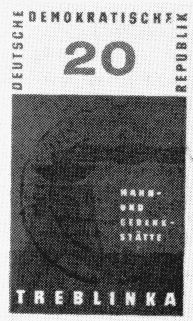
3. German Democratic Republic, August, 1963. Treblinka Memorial.
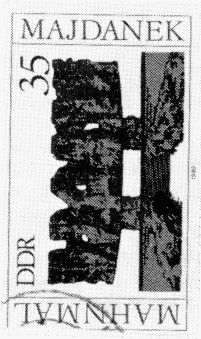
4. German Democratic Republic, 1980. Majdanek Memorial.
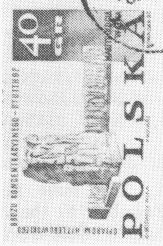
5. Poland, July, 1956. Warsaw Ghetto Monument.
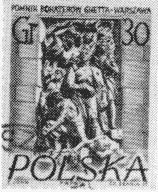
6. Poland, Oct., 1967. Stutthof Monument.

7. Czechoslovakia, May, 1967. Pinkas Synagogue Memorial. Menorah and fist of camps: Terezín (Theresienstadt), Belzec, Osvetim (Auschwitz), Gliwice (Gleiwitz), Buchenwald, Majdanek, Riga, Mauthausen, Ravensbrück.

8. Czechoslovakia, Feb., 1972. Lidice Memorial, dates 1942 and 1972.
Notes
| [1] | The huge payments of “reparations” by the German Federal Republic to the Zionist state in Palestine (which did not even exist before 1948) were made on the basis of the Luxembourg agreement of 10 September 1952. See Encyclopedia Britannica, 1970 edition, Vol. 2, page 88. For a discussion of the psychological motivations, see H. Stein, vol. 1, no. 4., pp. 309-322 of The Journal of Historical Review. |
| [2] | The author of this paper lived in Germany during 1945-1948 and was involved in the so-called “denazification” activities of the United States military forces, of which he was a member. He was thus in a position to hear a variety of views on the war. |
| [3] | The reasons for the general popularity of the National Socialist government in Germany and to some extent even beyond the German borders are too complex to describe in detail here. Suffice it to say that the main reasons were probably the reduction of the rate of unemployment from that of the final years of the Weimar Republic and the restoration of a measure of national self-respect after the humiliations resulting from the Versailles Treaty. John Kenneth Galbraith, an economist dear to the hearts of “liberals” in many lands, characterizes the results of National Socialist economic policies as a “signal accomplishment.” (Money, Bantam edition of September, 1976, pp. 174-5.) |
| [4] | Again, there were factors involved here which are far too complex to analyze within the scope of this paper. |
| [5] | For documentation of such persecution, see Der moderne Index, published by the Verlag für Volkstum and Zeitgeschichtsforschung, Vlotho on the Weser, June 1980 (Historische Tatsache Nr. 7). |
| [6] | I recall broadcasts by the Deutschlandsender during the early years of the war. At the signoff before the playing of the national anthem and the Horst-Wessel-Lied this message was repeated nightly: “England hat den Krieg erklärt, Deutschland siegt, wird ihn beenden.” (England declared the war; Germany is winning and will end it.) |
| [7] | For an excellent summary of this involvement, see the book review by Charles Lutton, “Death from On High,” in The Journal of Historical Review, vol. I, no 3, pp. 247-254. |
| [8] | For the tremendous difference in the tonnage of bombs dropped, see James J. Martin’s, The Saga of Hog Island, Colorado Springs, 1977, pages 53 and 85. (Available from the IHR $4.50) I remember translating a report in 1947 or 1948 by Professor Percy Schramm of Göttingen on the German civilian deaths from bombing, which he estimated at 800,000 as I recall. This would seem to be about twelve times the number of civilians killed in England by German bombing. |
| [9] | Anthony Sutton approaches this matter in a rather reserved, almost apologetic manner in his important Wall Street and the Bolshevik Revolution (New Rochelle: Arlington House, 1974), pp. 185 ff. There are also a number of books and booklets from what might be called the Underground Press which discuss this matter in more explicit terms, of which the following are only a sample: Louis Marshalko, The World Conquorors, Christian Book Club, 1968 Frank L. Britton, Behind Communism, no date or place. Quotes! Quotes!! Quotes!!!, Los Angeles, no date. |
| [10] | At the outbreak of hostilities the Soviet Union had 20,000 tanks, some five times the number Germany could put in the field in Russia. P. Knightley, The First Casualty (1975), pp. 146 and 153. (available from the IHR, Hb $14.50, Pb $7.00) |
| [11] | The Katyn massacres of captured Polish officers and the “Holocaust” material are, of course, essentially different topics, but Roosevelt’s highhanded efforts to suppress the knowledge of Soviet guilt in the massacres are instructive. (See Louis FitzGibbon, Katyn, The Noontide Press, Torrance, 1979, pp. 183-4.) It seems to me that one of the most striking and readily verifiable disproofs of the extermination thesis is the contrast between the German behavior after their discovery of the mass graves at Katyn in 1943 and the behavior of the Communists after their capture of the Auschwitz terrain of 27 January 1945. The Germans not only thought that they had nothing to hide, but invited international organizations, foreign forensic experts, foreign journalists and even some Allied prisoners of war to witness the gruesome evidence of the massacre which had obviously been carried out by their communist enemies. The German exploitation of the Katyn evidence should have been not only a propaganda victory for Germany, but also a stern admonishment to the United States and other allies of the USSR as to the nature of their ally. If ‘proofs of the extermination thesis would have been present at Auschwitz and other camps captured by the Soviets, they could easily have attained an even greater propaganda victory by doing just what the Germans had done in 1943, rather than just the opposite. Moreover, they had every incentive for striving for such a victory had the evidence actually been present. |
| [12] | Journal of Historical Review, vol. 1, no 2, p 181, where Nemesis at Potsdam by Alfred M. de Zayas (1977) is reviewed. For a statistical breakdown of the deaths and populations involved in the expulsions, see page XXV of this book. (available from the IHR, $9.00). |
Bibliographic information about this document: The Journal of Historical Review, vol. 3, no. 2 (summer 1982), pp. 105-118
Other contributors to this document: n/a
Editor’s comments: n/a
